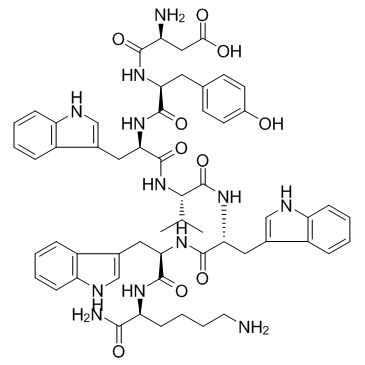Intrathecally administered D-cycloserine produces nociceptive behavior through the activation of N-methyl-D-aspartate receptor ion-channel complex acting on the glycine recognition site.
Koichi Tan-No, Akihisa Esashi, Osamu Nakagawasai, Fukie Niijima, Seiichi Furuta, Takumi Sato, Susumu Satoh, Hajime Yasuhara, Takeshi Tadano
Index: J. Pharmacol. Sci. 104(1) , 39-45, (2007)
Full Text: HTML
Abstract
Intrathecal (i.t.) administration of D-cycloserine (100 and 300 fmol), a partial agonist of the glycine recognition site on the N-methyl-D-aspartate (NMDA) receptor ion-channel complex, produced a behavioral response mainly consisting of biting and/or licking of the hindpaw and the tail along with slight hindlimb scratching directed toward the flank in mice, which peaked at 5 - 10 min and almost disappeared at 15 min after the injection. The behavior induced by D-cycloserine (300 fmol) was dose-dependently inhibited by an intraperitoneal injection of morphine (0.5-2 mg/kg), suggesting that the behavioral response is related to nociception. The nociceptive behavior was also dose-dependently inhibited by i.t. co-administration of 7-chlorokynurenic acid (0.25-4 nmol), a competitive antagonist of the glycine recognition site on the NMDA receptor ion-channel complex; D-(-)-2-amino-5-phosphonovaleric acid (62.5-500 pmol), a competitive NMDA receptor antagonist; MK-801 (62.5-500 pmol), an NMDA ion-channel blocker; ifenprodil (0.5-8 nmol); arcaine (31-125 pmol); and agmatine (0.1-10 pmol), all being antagonists of the polyamine recognition site on the NMDA receptor ion-channel complex. However, [D-Phe7,D-His9]-substance P(6-11), a specific antagonist for substance P (NK1) receptors, and MEN-10,376, a tachykinin NK2-receptor antagonist, had no effect on D-cycloserine-induced nociceptive behavior. These results in the mouse spinal cord suggest that D-cycloserine-induced nociceptive behavior is mediated through the activation of the NMDA receptor ion-channel complex by acting on the glycine recognition site and that it does not involve the tachykinin receptor mechanism.
Related Compounds
| Structure | Name/CAS No. | Molecular Formula | Articles |
|---|---|---|---|
 |
(Tyr5,D-Trp6.8.9,Lys-NH2¹⁰)-Neurokinin A (4-10)
CAS:135306-85-3 |
C57H68N12O10 |
|
Effects of substance P on identified neurons of the rat dors...
2001-07-01 [Am. J. Physiol. Gastrointest. Liver Physiol. 281(1) , G164-72, (2001)] |
|
Neurokinin receptors modulate the impact of uncontrollable s...
2007-10-01 [Behav. Neurosci. 121(5) , 1082-94, (2007)] |
|
Intrathecal administration of neurokinin 1 and neurokinin 2 ...
2007-02-01 [Behav. Neurosci. 121(1) , 186-99, (2007)] |
|
Effect of melatonin on the vasopressin secretion as influenc...
2007-12-01 [J. Physiol. Pharmacol. 58(4) , 829-43, (2007)] |
|
Differential role of neurokinin receptors in human lymphocyt...
2000-12-22 [Regul. Pept. 96 , 17-21, (2000)] |